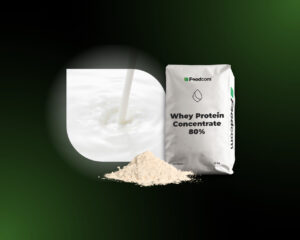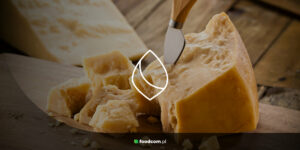- The milk powder (SMP) market remains stable, with signs of possible price increases in the coming months.
- Lactose prices are high thanks to strong demand from Asia, despite price differences between markets.
- The cheese and milk fat segment remains stable, although European exports are facing difficulties.
- The whey and WPC80 market remains supported by demand, but competition from the US is growing.
Welcome Partners!
Welcome back to our newsletter!
May brings stability in many segments of the dairy market, although there is no shortage of signals of possible change. In this issue, we analyse the price situation on the markets for skimmed milk powder, lactose, cheese and whey products, among others. We also examine how growing demand in Asia, competition from the USA and the seasonal peak in raw milk supply are affecting availability and purchasing strategies in Europe.
Let’s see what is happening in the market and what we can expect in the coming weeks!
Milk powder
The market for skimmed milk powder (SMP) for food use remains stable, with prices remaining around 2,300 EUR/MT. Export interest remains at a reasonable level and recent international tenders suggest a potential price increase in the coming months.
Non-standard SMP for feed purposes is offered at 2400 EUR/MT for Q2 delivery and 2450 EUR/MT for Q3 delivery. These levels reflect the relatively calm market situation and good availability of raw materials.
Food grade lactose prices in Europe remain high, driven by strong demand from Asian importers. Despite the significant price differential with the US, there has not yet been a significant change in transatlantic trade volumes.
Cheese
Cheddar cheese prices remain under pressure, mainly due to more competitive offers from abroad and unfavourable exchange rates. Export opportunities for European producers remain limited.
The mozzarella market remains balanced, although increased production and weaker export activity are resulting in greater availability on the domestic market.
Fats
Block butter prices remain stable at 7100-7200 EUR/MT EXW. Lower offers have also been recorded in Eastern Europe. Production costs remain high, especially given the current level of cream prices.
The milk fat market remains quiet, with no clear signals regarding price movements. Some participants are monitoring the situation for potential corrections in the coming weeks.
Liquids
Cream prices remain in the 7800-7900 EUR/MT FCA range. Although previously reported slightly lower, the market is showing signs of strengthening again, driven by an increase in processing activity.
Skimmed milk concentrate is priced at 1550-1650 EUR/MT forGerman-sourced product and 1400-1500 EUR/MT for UK-origin product delivered to the Netherlands. Product availability remains high.
The seasonal peak in raw milk supply continues to affect spot market prices. At the same time, milk payments to farmers have increased, widening the gap between spot and long-term prices.
Whey powder
The market for sweet whey powder for food use remains stable, with prices fluctuating in the range of 975-995 EUR/MT. Despite continued global competition, demand, particularly from Asia, is supporting the market.
Prices for SWP for feed purposes have fallen, with wholesale transactions in May at around 860 EUR/MT and in Q3 at 900 EUR/MT. The high availability of liquid whey continues to put pressure on prices.
Whey concentrate prices remain in a stable range, depending on protein and dry matter content. Logistical challenges may affect delivery times in different EU regions.
WPC 80 prices in Europe remain high due to limited supply and increasing demand in Asian markets. Some importers are turning to cheaper alternatives from the US, although not all processing plants in Europe can use products from outside the EU due to regulatory or technical restrictions.
After a good start to the year, the MIP market is showing signs of a correction. Some traders are liquidating excess stocks, which has increased availability on the spot market. Nevertheless, protein consumption remains high and continues to support demand.
Whey permeate prices in Europe are currently constrained by competitive offers from the US. With the decline in exports to Asia, US producers are looking for alternative markets, leading to more price competition in the EU.
What else?
Europe
Austria has closed 24 smaller border crossings with Hungary and Slovakia to prevent the spread of foot-and-mouth disease (FMD) following an outbreak in neighbouring countries. The UK has also suspended imports of live cattle, pigs, sheep, goats and related products from Austria, Hungary, Slovakia and Germany due to FMD concerns. The measures are aimed at protecting livestock farms from the highly infectious virus, which attacks cloven-hoofed animals and can lead to significant economic losses.
North America
The United States Department of Agriculture (USDA) forecasts an increase in US milk production in 2026, driven by increased herds and improved productivity of dairy cows. Despite increased supply, moderate pressure on prices is expected, with a slight decline in Class III milk prices, but continued strong domestic and export demand. Foreign sales of products such as whey, lactose and cheese are expected to increase, while butter imports are expected to increase. The overall market situation remains balanced, although herd growth may be limited by reduced heifer availability.
Globally
The World Trade Organisation (WTO) is sounding the alarm over rising trade tensions that are increasingly affecting global trade in agricultural products, including dairy products. New tariffs introduced by the US have prompted retaliation from the European Union, including additional tariffs on US agricultural products. Formal complaints have also been made by China and Canada. Despite these difficulties, the value of world trade in agricultural products increased by 3% last year, mainly due to a surge in the prices of coffee, tea and cocoa. However, the WTO stresses that without stable and predictable trade rules, the agricultural market could soon face more serious disruptions.
![Stability, tensions and exports – an overview of the dairy market [267th Edition of DAIRY Newsletter] Stability, tensions and exports – an overview of the dairy market [267th Edition of DAIRY Newsletter]](https://foodcom.pl/wp-content/uploads/2024/06/Foodcom_SA_Dairy_Newsletter_3-1520x760.jpg)






